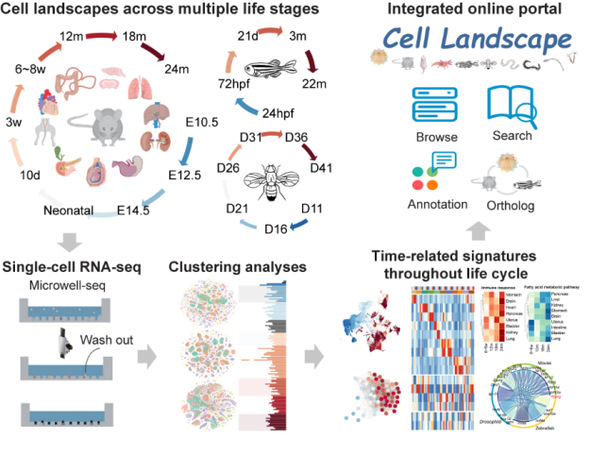Cross-species cell landscape constructed at single-cell level
Thanks to high-throughput single-cell RNA sequencing (scRNA-seq), it is possible to construct single-cell transcriptomic atlases at the organic level. For example, cell atlases for vertebrate and invertebrate systems have been successfully generated, such as Human Cell Landscape (HSC), Mouse Cell Atlas (MCA), Zebrafish Cell Landscape (ZCL) and Drosophila embryo. However, most of these studies are limited to one specific species or period and thus fail to make a thorough comparison between different species and tissues.
The research team led by Assoc. Prof. HAN Xiaoping and Prof. GUO Guoji at the Zhejiang University School of Medicine used Microwell-seq technology to profile over 2.6 million single cells from mice, zebrafish and Drosophila at different life stages. On the strength of these comprehensive datasets, they constructed a cross-species cell landscape and investigated common pathways that change throughout their life span. Their findings are published in the journal Nucleic Acids Research.

HAN & GUO et al. identified the tendency of cell types and genes that changed with development and age in mice, zebrafish and Drosophila, and found that the proportions of immune cells gradually increased with age in the three species. In mice, the proportion of T cells declined with age whereas that of B cells increased; the inflammatory response of tissues also ascended with age. Gene expression trajectories showed similar trends across the three species throughout their life cycle: immune responses were activated while mitochondrial metabolism-related pathways were down-regulated. Moreover, transcription factor regulation analysis revealed that some cell lineages were regulated by similar gene families across species.
Cross-species analysis in mice, rats, zebrafish, Drosophila and Nematostella demonstrated that immune responses and mitochondrial functions were two important signaling pathways in the aging process. By gauging transcription factor activity and the correlations between up-regulated and down-regulated genes, HAN & GUO et al. identified some transcription factors that may get involved in immunity, lipid metabolism and energy metabolism and play regulatory roles in the aging process in multiple species. By treating two-year-old mice with the FDA-approved drug pioglitazone (PGZ), they found that the aging phenotype was alleviated. This revealed that mitochondrial metabolism and inflammation during aging might be interconnected via intrinsic regulatory networks, and PGZ treatment could effectively modulate the oxidative and inflammatory status, cell senescence and lipid metabolism.
This study is expected to provide valuable resources for research on lineage development, maturation and aging.